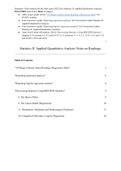Samenvatting
Summary Statistics II: Applied Quantitative Analysis Notes on Readings - GRADE 8,5
- Instelling
- Universiteit Leiden (UL)
Summary of the material for the final exam (2022) for Statistics II: Applied Quantitative Analysis. INCLUDES notes from (Total: 42 pages): Abby Long’s guide (2016) “10 Things to Know About Reading a Regression Table” for EGAP’s website. Tom Louwerse’s guide “Reporting regression a...
[Meer zien]





